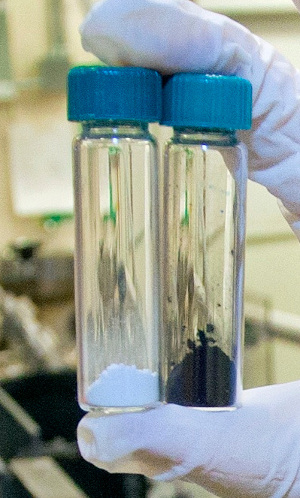Titania Photocatalysis
February 16, 2011
Titanium is an abundant
element. The
Earth's crust is about a half percent titanium by weight, which makes it about a tenth as plentiful as
iron, and that's a lot. Titanium metal is difficult to refine from its
minerals, so it comes at a high price (presently about twelve dollars per pound); but its oxide (
titanium dioxide, TiO
2, also called titania) is an abundant material that's used as a
pigment in
opaque white
paint. Titania is relatively inexpensive, and it would be nice if you can get it do something more useful than reflect white light.
Fortunately, titania is a
photocatalyst; that is, it will promote some
chemical reactions in the presence of light, usually the
ultraviolet portion of the
spectrum. As I've reported in a
previous article (The High Road, September 22, 2010), there are attempts to use titania in paving blocks in combination with the ultraviolet contained in sunlight to mitigate
vehicle exhaust.
The photocatalytic properties of titania were first published in 1972 by Akira Fujishima and Kenichi Honda, who described a
photoelectrochemical cell that used titania as a
photoanode.[1-2] This cell was capable of
water photolysis; that is
splitting water into
hydrogen and
oxygen. This was big news in my research circles, since we were investigating
materials for hydrogen storage as portable energy sources, and the Fujishima-Honda cell was a potentially important piece in a
hydrogen economy. Unfortunately, the
bandgap of titania as
rutile is 3.0
eV, which means it will only split water when illuminated by light shorter in
wavelength than 413.75
nm. Less than 10% of solar energy appears in those wavelengths. The other crystal form of titania,
anatase, is even worse at 3.2 eV (388 nm). In short, titania was not a practical solar energy collector.
If you're trying to decrease the bandgap of titania,
doping is one route. The material is difficult to dope, owing to the small
atomic size of the titanium
cation, although
nitrogen has been somewhat effective. One clue to another way of bandgap modification is the difference in bandgap between the rutile and anatase structures. They're both titania, but the arrangement of atoms is slightly different, and this leads to a different bandgap. Nowadays,
nanotechnology is applied to everything, often with good results, and that appears to be the case for titania, as well. A research group from
Lawrence Berkeley National Laboratory and the
University of California at Berkeley has just published results of a new study on titania for photocatalysis.[4-5]

White on the left, black on the right. The results of hydrogen-induced disorder in titania nanocrystals. The gloved hand is that of principal investigator, Samuel Mao (Photo by Roy Kaltschmidt, Lawrence Berkeley Laboratory).
The Berkeley team enhanced the solar absorption of titania by introducing surface disorder in TiO
2 nanocrystals by hydrogenation. The process turned the titania from white to black, a change indicative of increased
optical absorption. The TiO
2 nanocrystals performed
photo-oxidation of
organic molecules in water, a process that's important for
remediation of contaminated water. Introducing this disorder enabled absorption of
infrared light.
Computer calculations show that the disorder created mid-gap electronic states, similar to doping, but it also reduced the
intrinsic bandgap. This work appears in the February 11, 2011, issue of
Science.[4]
Experiments showed that nearly a quarter of the
solar spectrum was absorbed by the disordered titania. In photolysis, the titania had about a hundred-fold better hydrogen yield than other photocatalysts, and it showed no sign of degradation after 22 days. The research was funded by the Energy Efficiency and Renewable Energy program of the
United States Department of Energy.
References:
- Akira Fujishima and Kenichi Honda, "Electrochemical Photolysis of Water at a Semiconductor Electrode," Nature, vol. 238, no. 5358 (July 7, 1972), pp. 37-38.
- J. Keeney, D. H. Weinstein and G. M. Haas, "Electricity from photosensitisation of titanium," Nature, vol. 253, no. 5494 (February 27, 1975), pp. 719-720.
- Afshin Ebrahimi, "Electrochemical Photolysis of Water at a Semiconductor Electrode," June 1, 2008.
- Xiaobo Chen, Lei Liu, Peter Y. Yu and Samuel S. Mao, "Increasing Solar Absorption for Photocatalysis with Black Hydrogenated Titanium Dioxide Nanocrystals," Science, vol. 331, no. 6018 (February 11, 2011), pp.746-750.
- Dan Krotz, "A Dash of Disorder Yields a Very Efficient Photocatalyst," Lawrence Berkeley Laboratory Press Release, January 28, 2011.
Permanent Link to this article
Linked Keywords: Titanium; element;Earth's crust; iron; minerals; titanium dioxide; pigment; opaque; paint; photocatalyst; chemical reaction; ultraviolet; spectrum; vehicle exhaust; photoelectrochemical cell; photoanode; water photolysis; splitting water; hydrogen; oxygen; metal hydrides; materials for hydrogen storage; hydrogen economy; bandgap; rutile; electronvolt; eV; wavelength; nanometer; nm; anatase; semiconductor doping; atomic radius; atomic size; cation; nitrogen; nanotechnology; Lawrence Berkeley National Laboratory; University of California at Berkeley; Samuel Mao; optical absorption; photo-oxidation; organic; environmental remediation; infrared light; Computer calculations; intrinsic bandgap; Science; experiment; solar spectrum; United States Department of Energy.